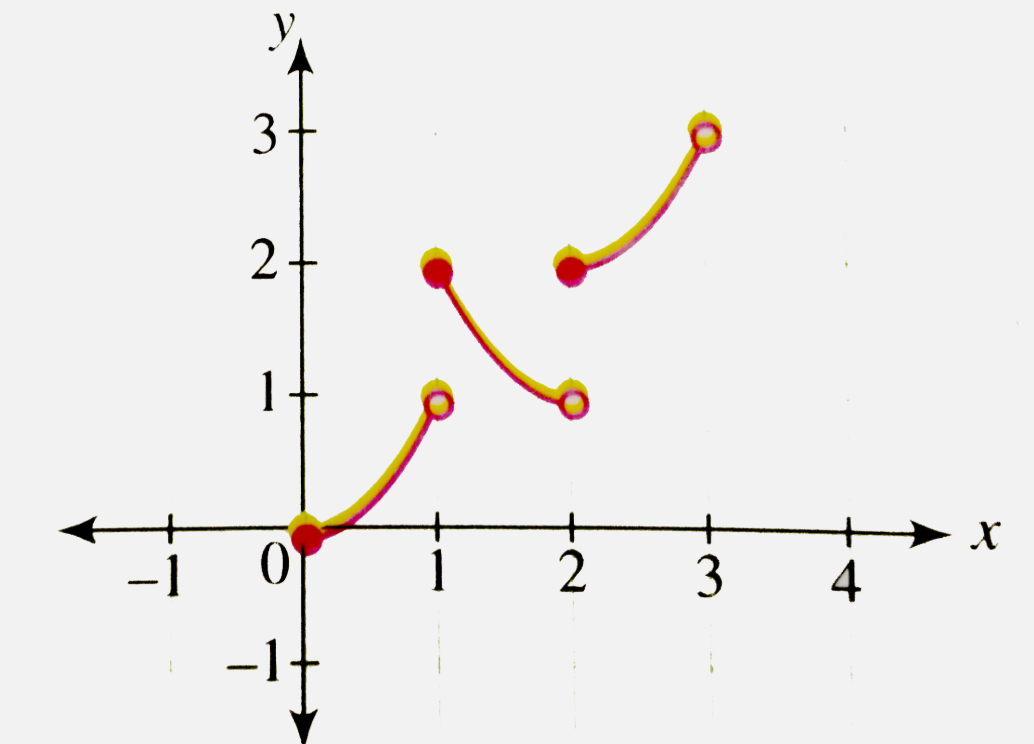f(x)=sin[x]+[s∈x],0<x<π2 where [.] represents the greatest integer function, can also be represented as {0,0<x<11+s∈1,1≤x,π2 {1√2,0<x<π41+12+1√2+32,π4≤x<π2 {0,0<x<1s∈1,1≤x<π2 {1,π4<x<1s∈1,1≤x<π2Solution in Tamil
{0,0<x<11+sin1,1≤x<π4
⎧⎪⎨⎪⎩1√2,0<x<π41+12+1√2+√32,π4≤x<π4
{0,0<x<1sin1,1≤x<π2
⎧⎪ ⎪ ⎪⎨⎪ ⎪ ⎪⎩0,0<x<π21,π4<x<1sin1,1≤x≤π4
The correct Answer is:C
0<x<π2
∴ [x]={0if0<x<11if1≤x<π2
⇒ sin[x]={sin0=0if0<x<1sin1if1≤x<π2
we have 0sinx<1 when 0<x<π2.
∴ [sinx]=0 for 0<x<π2
∴ sin[x]+[sinx]=(0if0<x<1sin1if1≤x<π2
Topper's Solved these Questions
- BOOK - CENGAGECHAPTER - FUNCTIONSEXERCISE - Multiple Correct Answers Type10videos
FUNCTIONS
- BOOK - CENGAGECHAPTER - FUNCTIONSEXERCISE - Comprehension Type7videos
FUNCTIONS
- BOOK - CENGAGECHAPTER - EQUATION OF PLANE AND ITS APPLICATIONS -IIEXERCISE - DPP 3.418videos
EQUATION OF PLANE AND ITS APPLICATIONS -II
- BOOK - CENGAGECHAPTER - GETTING STARTED WITH GRAPHSEXERCISE - Exercise18videos
GETTING STARTED WITH GRAPHS
Similar Questions
The function f(x)=cos−1⎛⎝2[|sinx|+|cosx|]sin2x+2sinx+114⎞⎠ is defined if x belongs to (where [.] represents the greatest integer function)
05:14View SolutionLet f(x)=x2−2x−1∀x∈R Let f:(−∞,a]→[b,∞), where a is the largest real number for which f(x) is bijective. If f:R→R , g(x)=f(x)+3x−1 , then the least value of function y=g(|x|) is
04:14View SolutionLet A(0,6,6), B(6,6,0) and C(6,0,6) are three points and point D is moving on the line x+z−3=0=y. If G is centroid of ΔABC, then minimum value of GD is
01:39View SolutionDoes the following graph pass the vertical or horizontal line test ?
 02:45View Solution
02:45View SolutionThe function f(x)=tan−1(sinx+cosx) is an increasing function in (1) (π4,π2) (2) (−π2,π4) (3) (0,π2) (4) (−π2,π2)
04:12View SolutionThe range of f(x)=sin−1(√x2+x+1)is (0,π2) (b) (0,π3) (c) (π3,π2) (d) [π6,π3]
03:14View SolutionThe function f(x)=tan−1(sinx+cosx) is an increasing function in (−π2,π4) (b) (0,π2) (−π2,π2) (d) (π4,π2)
02:49View SolutionIff(x)=Asin(πx2)+b,f′(12)=√2and ∫10f(x)dx=2Aπ,thenconstantsAandBare π2andπ2 (b) 2πand3π 0and−4π (d) 4πand0
05:14View Solutionf(x)=sin[x]+[s∈x],0<x<π2 (where [.] represents the greatest integer function), can also be represented as {0,0<x<11+s∈1,1≤x,π2 {1√2,0<x<π41+12+1√2+32,π4≤x<π2 {0,0<x<1s∈1,1≤x<π2 {1,π4<x<1s∈1,1≤x<π2
05:35View SolutionThe value of F(x)=6cos x sqrt(1+tan^(2)x)+2sin x sqrt(1+cot^(2)x) where x in(0,2 pi)-{pi,(pi)/(2),(3 pi)/(2)} may be
03:09View SolutionIf {(sin{cos x})/(x-(pi)/(2)),x!=(pi)/(2) and 1,x=(pi)/(2) where {.} represents the fractional part function,then f(x) is
View Solutionf(x)=√−x2+4x−3+√sinπ2(sinπ2(x−1))
06:56View SolutionIf f(x) is continuous at x=π, where f(x)=√2+cosx−1(π−x)2, for x≠π, then f(π)=
04:59View Solution[" The range of the function "f(x)=sin^(-1)((sqrt(1+x^(4)))/(1+5x^(10)))" is "],[[[-(pi)/(2)*(pi)/(2)]],[0[(pi)/(3)*(pi)/(2))],[0(0,(pi)/(2)]]]
10:05View Solutionlimx→π/2√1−sinx(π/2−x)√1+sinx=
04:25View SolutionRange of the function f(x)=√cos−1(√log4x)−π2+sin−1(1+x24x) is equal to (A) (0,π2+√π2] (B) [π2,π2+√π2] (C) [π6,π4) (D) {π6}
02:39View Solution

